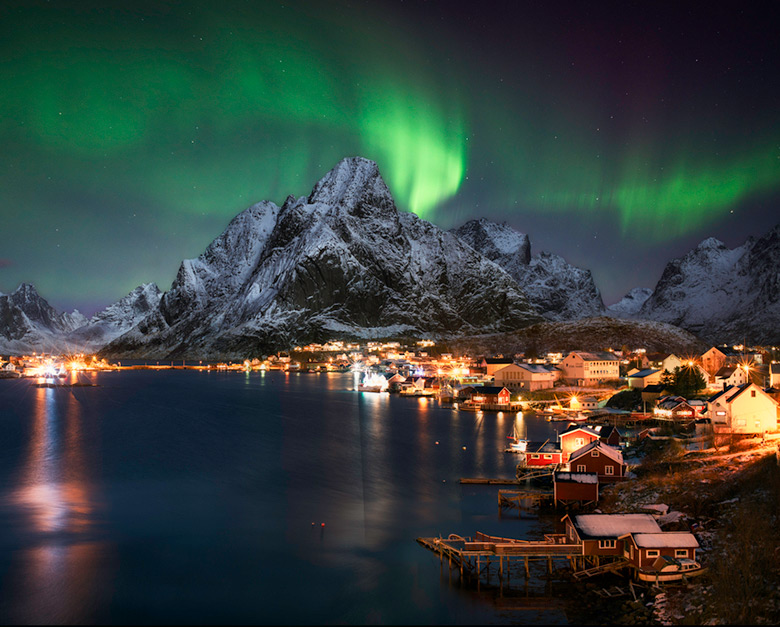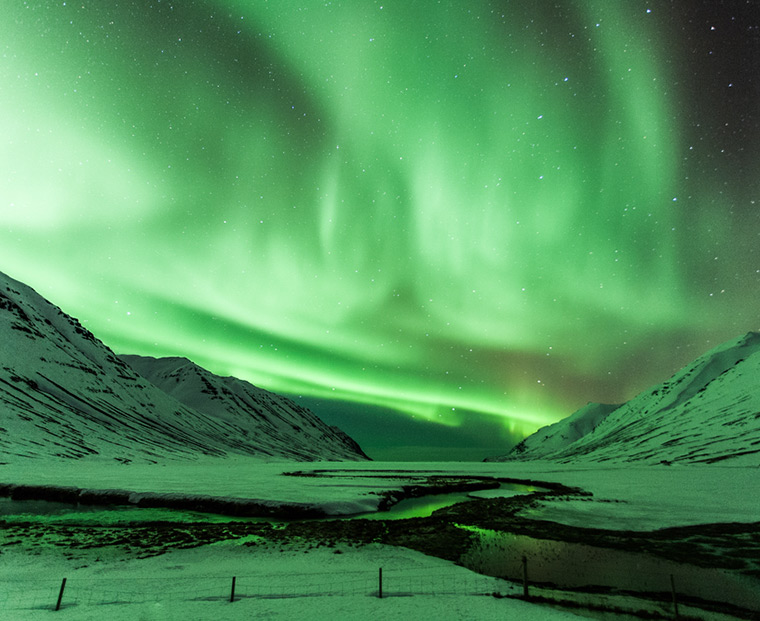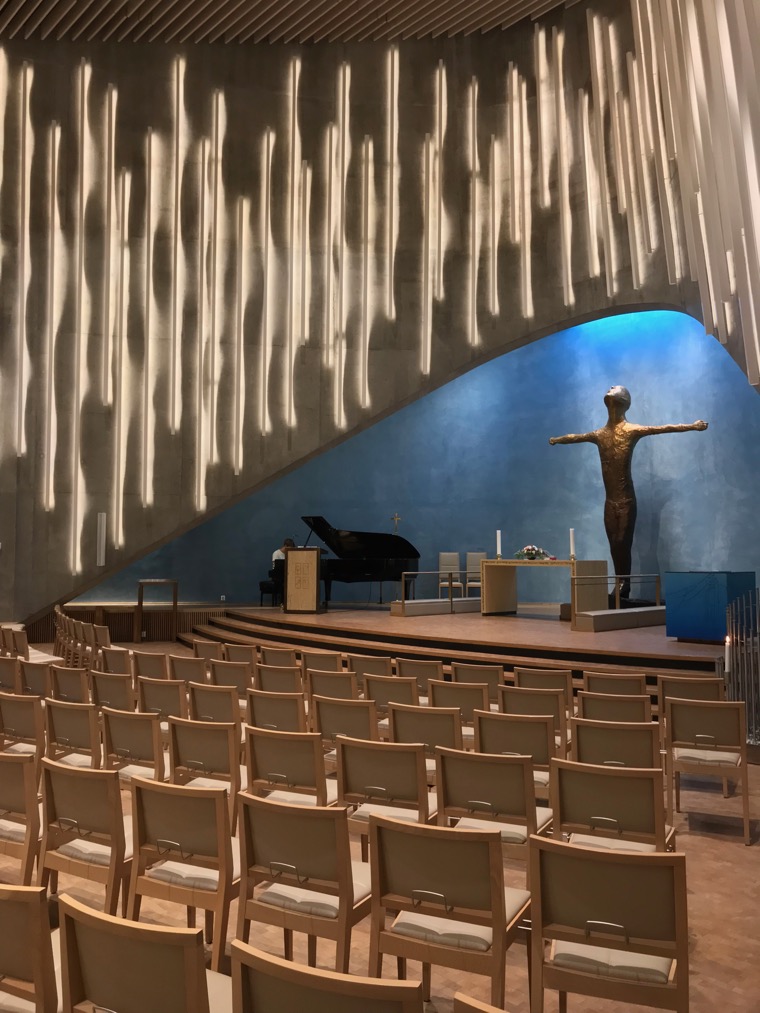Learn more about the aurora borealis with these fun northern lights facts.
Have you seen the northern lights? They dance high above our heads when the sky is dark, and draw many thousands of tourists to Norway.

Some people are underwhelmed, others leave with a lifelong memory. Much depends on the strength of the display you see.
Having grown up in middle England, I never glimpsed the lights until I moved to Norway. All I had was a story from my mother, who glimpsed the aurora one night while wandering on a remote Scottish island beach with her grandfather.
Since moving to Norway I've managed to see the lights many times, including just a few days ago here in Trondheim! In my research for my Moon Norway guidebook, I spoke to many aurora experts and tour providers to learn more about this bizarre natural phenomenon.
So, if you're at all curious about the aurora borealis, join me and let's dive into these fascinating northern lights facts!

The mythology of the northern lights
Of course, we know today what causes the northern lights. But before we knew the science, it's understandable that our ancestors struggled to comprehend what they were seeing.
Many myths and legends around the world are associated with the northern lights, as indigenous people tried to make sense of what they saw.
1. The northern lights feature in Norse mythology
One Norse legend has the lights as reflections from the shield and armour of the Valkyries. These female warriors would choose which of the fallen would gain entry to Valhalla. Norse legends also suggest that these pulsating green ribbons of light served as an archway into Valhalla.

2. The northern lights play a part in Chinese dragon legends
Given the latitude, sightings of the lights in China are always rare. That means that on the rare occasions a significant solar event caused a sighting in China, the impact was signifiant.
It is said that many early Chinese legends about dragons can be linked to these rare light shows, taken to be a battle between good and evil dragons.
3. Some Europeans saw the aurora as a harbinger of war
Not everyone associated the lights with gods or postivity. In fact, in the British Isles the skies were said to have ‘blazed red' just a few weeks before the French Revolution.
Meanwhile, in Italy and France the lights were believed to be a bad omen that could herald the outbreak of anything from war to plague. If you happen to see the lights, keep an eye on your health!

4. Japanese culture associates the aurora with luck
The aurora legends also include fertility! In Japanese culture for example, a child conceived during a northern lights display will be blessed with good looks, intellect and good fortune.
The science of the northern lights
While I'm fascinated by the myths and legends associated with the lights, I'm just as fascinated by the science. Now, let's take a look at what we know about the causes of this wonderful light show.
5. The northern lights are initially caused by the sun
While the lights occur in the Earth's atmosphere, their cause lies around millions of kilometres away on the surface of the sun.
Here, massive explosions of electromagnetic matter called coronal mass ejections (CMEs) hurl charged particles into space. Known as a solar wind, these particles make their towards earth where they cause the lights a few days later.

6. An aurora display is actually a distortion in the earth's magnetic field
When the solar wind reaches the earth, it causes a distortion in the magnetic field. Most of the charged particles are deflected away, but some make it into the atmosphere close to the two magnetic poles.
This collision of the charged particles and the gases in our atmosphere cause the light, which is a release of photon energy.
7. The northern lights occur around 100km above the earth
When you're watching an especially strong northern lights display, it can seem as if you could almost reach out and touch them. But in actual fact, the lights are high up in our planet's atmosphere.
How high? According to Norway's UiT, the lights are generally found between 90km and 130 km above ground level, although they can be even higher.
8. The northern lights are only visible when it's dark, but they can occur at any time
Contrary to what some people think, the aurora borealis can occur at any time of day. However, our eyes need darkness to be able to perceive them.
This means that the days around a full moon are not the best for hunting the lights. It also explains why it's best to get far away from the lights of towns and cities to maximise your chances of a sighting.

9. The lights occur in an oval-shaped band around the poles
Remember those charged particles that enter our atmosphere near the poles? From space, a northern lights display is often seen as an oval around the poles–and that's what you see on prediction software.
The auroral oval is fixed in a relation to the sun, while the earth revolves below. However, the stronger the charged particles, the farther away from the poles they enter the atmosphere, causing the oval to expand, and with it, the visibility range.
Read more: Surfing Under the Northern Lights
10. The best places to see a display change over time
The auroral oval relates to the magnetic poles and not the geographical poles. Magnetic poles move over time, taking the auroral ovals with them. While year-to-year changes are minor, over time they can be significant.
Experts believe that 500 years ago, the auroral oval was probably located over southern Norway. This means that while today is a great time to see the lights in northern Norway, that won't always be the case.

Other northern lights facts
Okay, enough science for now! Let's take a look at some other interesting info about the aurora borealis.
11. People study the northern lights for a living
Well, maybe we're not quite ready to leave science just yet! The study of the aurora borealis is a potential career for a budding scientist, albeit an extremely niche specialism. It's not a modern specialism, though!
Norwegian mathematician and astrophysicist Carl Størmer (1874–1957) studied the movement of charged particles in the magnetosphere. Scientist Kristian Birkeland was another early pioneer. He went on to receive seven Nobel Prize nominations.
In 1939, Norwegian physicist Lars Vegard proved hydrogen emissions in aurora borealis. Nine years later, he pointed out the doppler effect in hydrogen lines of aurora borealis.
12. The first aurora photograph was taken more than 125 years ago
It was German physicist and astronomer Otto Rudolf Martin Brendel (1862–1939) who took the first known photograph of the aurora borealis.
Taken on 5 January, 1892, the black-and-white photo was published in ‘The Century' magazine in October 1897.

13. The northern lights is big business for Norway
Many people know of northern lights tourism, but few appreciate the extent of the industry. Northern cities like Tromsø and Alta promote northern lights tours above anything else during the winter season.
According to a 2017 report from Innovation Norway, “northern lights” was behind only fjords and glaciers as search terms tourists used when looking for information on visiting Norway. The same report revealed that of all international tourists to Norway, 21% hoped to experience a northern lights display.
14. Norway has a church inspired by the northern lights
Such is its popularity as an aurora spotting location, northern Norway's Alta terms itself the northern lights city. The lights have even inspired the design of its modern church.
Known as the northern lights cathedral, the exterior and interior both feature design elements inspired by the movement of the aurora.

15. The aurora australis are seen by far fewer people
Throughout this article, I've referred to the aurora borealis or the northern lights. But as mentioned earlier, the same happens at the other end of the planet.
However, because far less people leave in the aurora zone around the southern pole, the southern lights or aurora australis are glimpsed far less often than their northern siblings.
16. Other planets also have auroras
The aurora are not unique to Earth. Both Jupiter and Saturn have stronger magnetic fields and auroras have been observed on both gas planets. We know this from the Hubble Space Telescope and the Cassini and Galileo spacecraft.
Just like on Earth, the aurora on Saturn seem to be caused by the solar wind. However, the causes of Jupiter's aurora are more complex.
17. You can photograph the lights with a modern smartphone
When I first saw the lights, a decent DSLR camera was required to stand a chance of capturing the lights on film. But technology moves quickly.

When the lights danced above Trondheim last week, I was able to capture them using my iPhone XS. The photo wasn’t great, but given that I took the photo from inside my bathroom, I’m sure you’ll agree it is good enough for a memory!
Have you ever seen the northern lights? How was the experience for you? Let us know in the comments.


Great article! At what time and day did they appear in Trondheim? I live in Trondheim as well and went to Kuhaugen last Monday to see them (lots of activity according to nordlysvarsel.com). No luck though!
There’s never any guarantees in Trondheim even with good forecasts, unfortunately! The picture I took was a few days before that on the Thursday, at around 10.40pm.
Wow so petty
I live in New York State. The Northern lights are visible at times. I am in an area known as Upstate. I was pumping gas early one morning and the lights were in the sky swirling around. I really enjoyed watching them. Another time was on a back road, and it was dark. It was fun to watch them again. I love to see them.
You did not talk about the variation in color of the Northern Lights. For 20 years I lived in SW Iowa in the USA. One evening coming home from working at my school, I watches as the Northern Lights had both green and red. Almost had an accident as I was so fascinated by the color change between the green and red !
I would love to see the northern lights… I live in Alabama though and Iceland and Alaska are a little too far for me and my parents to travel though… But the pictures I have seen are beautiful! <3
It is beautiful! You need to see it, the camera does no justice!
Hi, I am curious, have the Northern Lights become more frequent and more of a ‘thing’, I lived in Northern Norway (Vesteralen) for a year as an exchange student in 1985/86 and although I knew of them there was no particular interest or great photography. Has it changed? Thanks